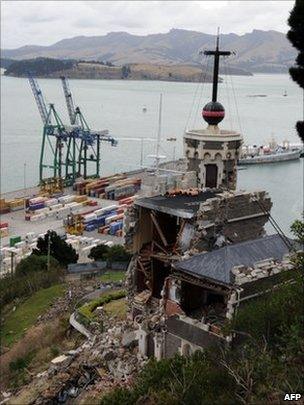Christchurch earthquake: 'No more survivors'
- Published
Civil Defence controller John Hamilton and Mayor Bob Parker at a news conference
No more survivors of the earthquake in Christchurch, New Zealand, are likely to be found and the task is recovery, not rescue, say relief officials.
Key buildings in the city, struck by a shallow quake of magnitude 6.3 last Tuesday, are being scoured for bodies; the official toll is now 161.
The first foreign victims have been formally named - two Israeli tourists.
Power, transport and sewage systems are gradually being restored but rebuilding the city is a daunting task.
The Civil Defence national controller John Hamilton announced the shift from rescue to recovery "with considerable sorrow and frustration".
"We now face the reality that there is no chance that anyone could have survived for this long," he said.
Officials say the final toll could be as high as 240; the last person to be pulled alive from the rubble was found over a week ago, one day after the earthquake struck.
Hopes fade
The formal identification of dead bodies from the quake has been proceeding slowly; officials said seven more had been identified but the families were being informed before the names would be announced.
Two Israelis found in the rubble have been named as Ofer Levy, 22, and Gabi Moshe Ingel, 23.
Scores of foreign students - from Japan, China, Thailand and elsewhere - have not yet been identified.
Police Superintendent Sam Hoyle said 90 of the bodies found so far were pulled from the Canterbury TV Building and that it was important for families that they got the identities right.
Workers at three major buildings - the cathedral, the Grand Chancellor hotel and the Pyne Gould Guinness building - were getting closer to bodies believed to be trapped inside.
A tall reinforced steel frame has been locked onto the cathedral structure to make it safer for rescuers to seek the suspected 20 bodies there.

The 135-year old Timeball Station in Lyttelton Harbour is at risk
"They've now started taking away beams and things from the bell tower, so we are at last going to see some movement in that area," said Superintendent Russell Gibson.
Timeball fear
Tens of thousands of city dwellers are still without power or sewage systems.
Rescue work is also being scaled back in Lyttelton, the harbour town near Christchurch, in favour of body recovery and the restoration of services.
The Timeball Station in Lyttelton is unstable and experts are assessing the extent of the "significant damage" to the historic structure.
It was built in 1876 by local prisoners and from then until 1934 a ball dropped from its mast on its stone tower, signalling the time to ships in the harbour.
Following restoration in 1978, the dropping of the ball resumed daily.
The port is operating at 40% capacity and the tunnel linking it to Christchurch is still only open to emergency vehicles.
Officials are still carrying out checks on people and houses.
"I suppose everyone's taking the double jeopardy approach, that if the doors are knocked on twice, that's better than not being knocked on at all," said Chief fire officer Mark Buckley.
On Wednesday, Police Superintendent Dave Cliff had warned that it might not be possible to recover all the dead from crushed buildings in New Zealand's second city.
Rebuilding costs are put at billions of dollars.
It is estimated that up to a third of the city's buildings have been, or will have to be, demolished.
CLICKABLE Select the images for more details.

Bexley

Streets in the north-eastern suburb of Bexley were flooded as the quake caused water mains to burst, which coincided with heavy rain.
Pyne Gould Guinness

The multi-storey Pyne Gould Guinness Building, which normally houses around 200 workers, collapsed. A number of people were thought to be trapped inside.
Cathedral

The 63m spire of the city's Anglican cathedral was toppled by the earthquake. A New Zealand TV reporter took a look inside the damaged building.
CTV building

Part of Christchurch's Canterbury Television [CTV] building completely collapsed in the earthquake. Some 24 people have been rescued from the building, but police said there might be between 60 and 120 bodies trapped underneath.
Oxford Terrace

In the aftermath of the earthquake, Rhys Taylor took this video on Oxford Terrace, 50 metres away from the city's main hospital. He said: "Cars were being used as ambulances to transport the injured."
- Published2 March 2011
- Published1 March 2011
- Published1 March 2011
- Published28 February 2011
- Published1 March 2011
- Published26 February 2011
- Published25 February 2011
- Published24 February 2011